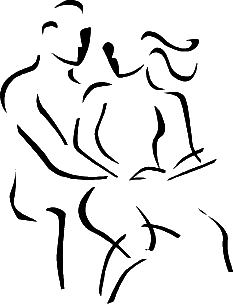|
| |
LASER
HAIR REMOVAL
LASER HAIR
REMOVAL FOR ALL SKIN TYPES

GentleLASE Plus™
LaserHair Removal
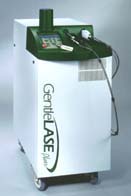
The GentleLASE
Plus™, by
Candela Corporation, effectively
removes unwanted body hair. Traditional hair removal techniques such as shaving,
plucking and waxing, provide only temporary relief and may actually stimulate
hair growth. Electrolysis, while effective, often requires years of ongoing
treatments. Candela believes that the technology used in the GentleLASE Plus™
hair removal laser may make all other methods of hair removal obsolete. Laser
hair removal works by targeting the pigment inside the hair follicle without
damaging delicate pores and structures of the skin. Because hair cycles through
"growth" and "dormant" phases, and because during the
"dormant" phase the follicle has no pigment, at least 4 to 6
treatments will be needed.
GentleYAG™
Laser Hair Removal
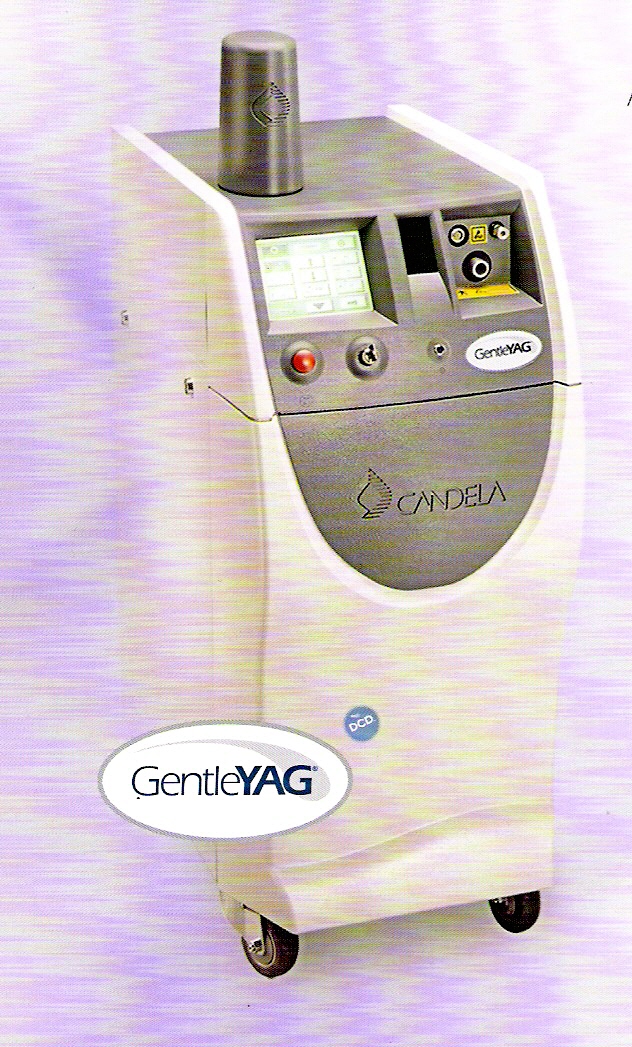

The new GentleYAG™
is FDA cleared to treat all skin types, including tanned skin, and offers
unmatched Nd:YAG treatment capabilities in permanent hair reduction, vascular
lesions, and wrinkles. Treat patients year-round with GentleYAG's 1064nm
wavelength, multiple spot sizes, variable pulse durations and DCD technology.
Treats all skin types - Deep penetration with minimal scattering of laser
energy makes GentleYAG ideal for all skin types, especially dark and tanned
skin.
Powerful - Fluences up to 600 J/cm² help make the GentleYAG the most
powerful Nd:YAG on the market today.
Epidermal Cooling - Candela's optional Dynamic Cooling Device (DCD)
technology provides consistent, reproducible epidermal cooling and patient
comfort.
Hair removal is much faster with a
laser as the laser is pulsed about once per second across the surface of the
skin. Each "pulse" of laser light disables a large numbers of hair
follicles. Electrolysis operators can only treat those hairs that they can see
and which they can reach the follicle through the hair shaft. A laser treats any
"active" follicle, even if the hair has not yet reached the surface of
the skin, or if the hair shaft is not straight.
Key Benefits of GentleYAG™
and GentleLASE
Plus™ Laser Hair Removal systems:
-
Larger areas can treated in a shorter time
- the areas treated can range from 8 mm (smaller than the size of a dime) to 18 mm
(larger than a size of a nickel) in diameter (see chart below)...
-
Laser treats "active" (anagen) hair follicles, even if the hair has not
reached the surface of the skin...
- Helps reduce ingrown hairs...
-
Over the period of treatment it is less
expensive than electrolysis...
-
FDA approved for permanent
hair reduction.
-
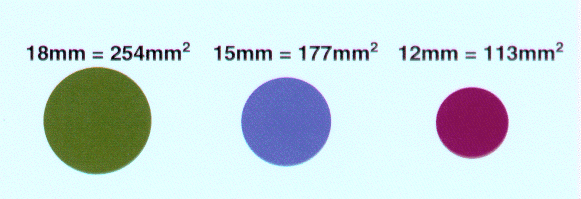
Relative comparison of spot sizes
|
LASER TREATMENTS
Skin Rejuvenation: Skin
Tightening/Wrinkle Removal … Candela's GentleYAG is used for
"skin tightening" treatments adding to the laser's current
applications for hair, leg and facial vein removal. The GentleYAG
"tightens" by heating the underlying layers in the skin and forming
new collagen resulting in smoother, younger looking skin. The
GentleYAG's patented epidermal cooling skin with every laser pulse
allowing for quick results and patient comfort.
Pigmented Lesions: Freckles, Age & Sun Spots,
Melasma …
Our GentleLASE laser is
extremely effective for the removal of pigmentation in freckles,
melasma, café au lait and age spots. With the GentleLASE we can
treat pigmented lesions with very effective results.
Vascular lesions such as leg and
facial veins … Candela's GentleYAG
laser can now be used for the removal of leg and facial veins. The
Dynamic Cooling Device (DCD) protects the skin with every laser
pulse allowing for quick results and patient comfort.
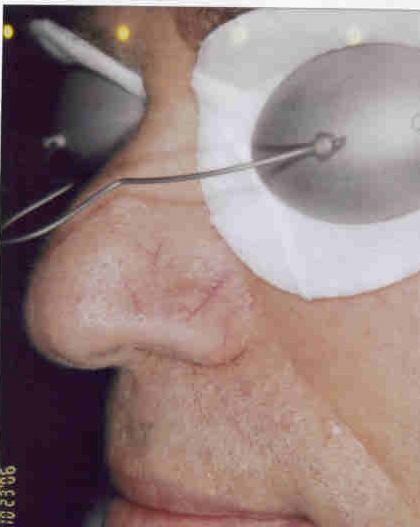
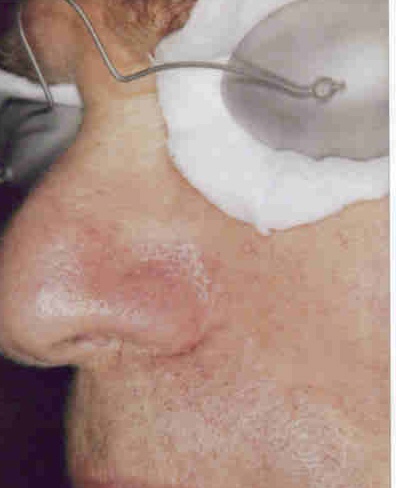
Facial veins on nose: A 63 year-old male before
(left)
and immediately after treatment. (Actual patient).
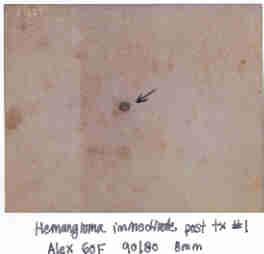
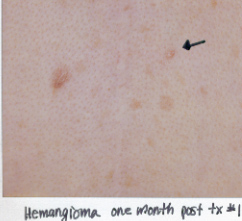
Hemangioma (arrow): 45 year-old female before
(left) and one month
after treatment #1.
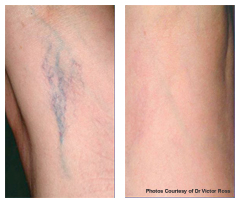
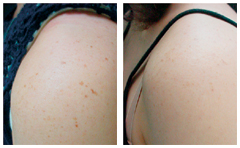
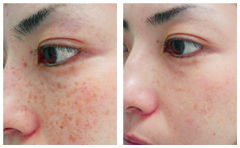
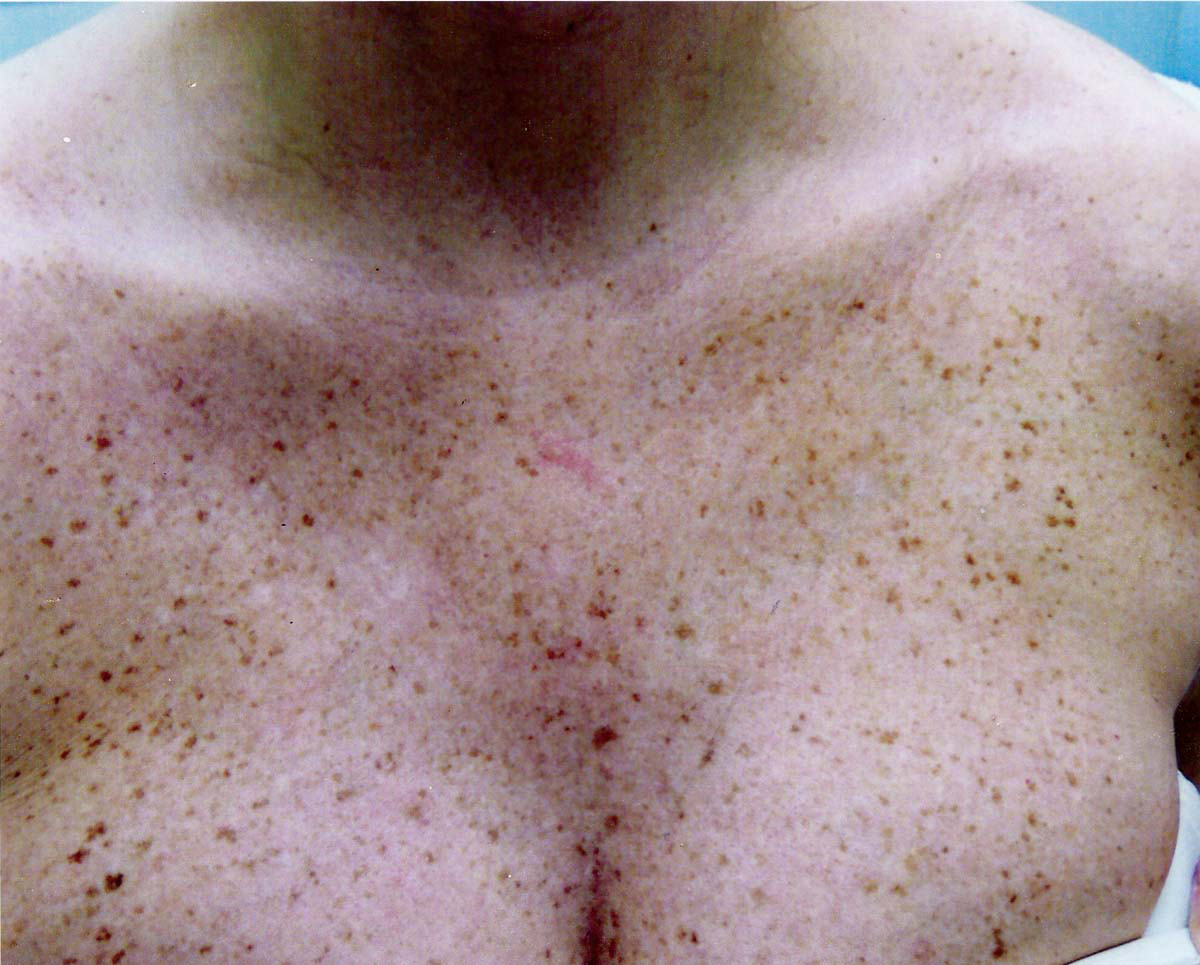
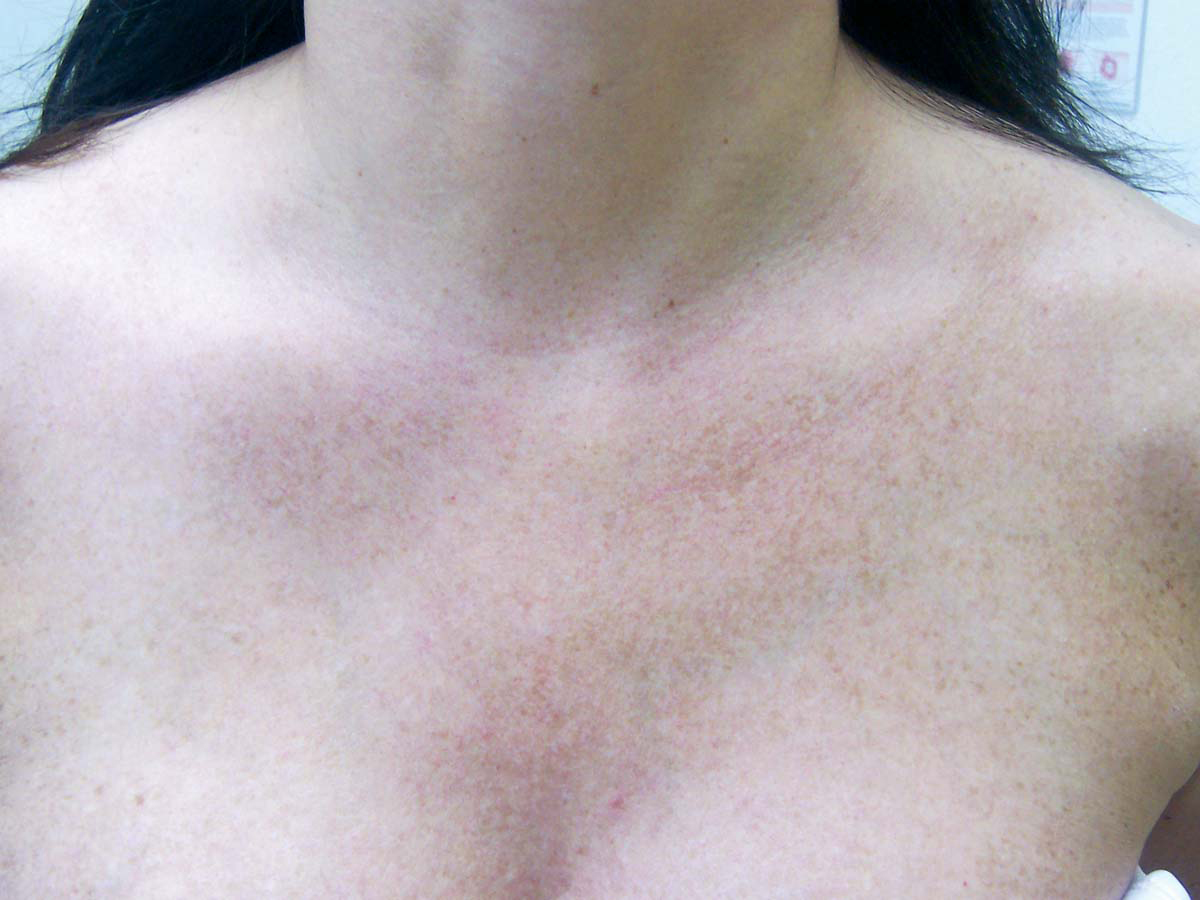
Pictures are courtesy of Candela Corporation.
|
FAQs
ABOUT LASER HAIR REMOVAL
How
does the GentleLASE Plus™ laser work?
The GentleLASE Plus™ effectively removes unwanted body hair. Traditional hair
removal techniques such as shaving, plucking and waxing, provide only temporary
relief and may actually stimulate hair growth. Electrolysis, while effective,
often requires years of ongoing treatments. At Candela, we believe that the
technology used in our GentleLASE Plus™ hair removal laser may make all other methods
of hair removal obsolete. Laser hair removal works by targeting the pigment
inside the hair follicle without damaging delicate pores and structures of the
skin. Because hair cycles through "growth" and "dormant"
phases, and because during the "dormant" phase the follicle has no
pigment, at least 2 or 3 treatments will be needed. We recommend a series of
three to six treatments.
Back
to Top of FAQs
What does the treatment involve?
The patient is asked to wear eye protection
consisting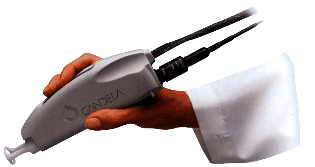 of an opaque covering or goggles. The area to be treated is then
shaved. A small hand piece or "wand" is then placed over the area
to be treated and the laser is "pulsed" emitting a beam of laser light
destroying the hairs within the spot on the hand piece (8mm, 12mm, 15mm, or
18mm). of an opaque covering or goggles. The area to be treated is then
shaved. A small hand piece or "wand" is then placed over the area
to be treated and the laser is "pulsed" emitting a beam of laser light
destroying the hairs within the spot on the hand piece (8mm, 12mm, 15mm, or
18mm).
Back
to Top of FAQs
What
are the advantages over electrolysis?
With electrolysis, the operator inserts a probe into the hair shaft with the intention of reaching the follicle, then sends a
small electrical charge designed to disable the follicle. The operator then
removes that particular hair with forceps. Hair removal is much faster with a
laser as the laser treats hundreds of follicles with a single pulse.
Back
to Top of FAQs
How many
sessions are needed?
The number of sessions will vary for each
individual. This is dependant upon age, gender, hormone levels, etc.
During the initial visit, the laser light disables those follicles in the
"active" phase of the growth cycle. Follicles in the "dormant" phase will not be
affected. Since follicles cycle through "active" and "dormant" phases,
additional sessions may be desired once the "dormant" follicles become "active".
For this reason, a series of treatments will be
necessary.
Back
to Top of FAQs
Is the
laser treatment painful?
While some areas of the body are more sensitive
than others, most patients report little or no discomfort. For more sensitive
patients, anesthetic creams can be applied prior to the treatment.
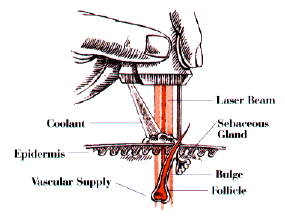
GentleLASE Plus's™ unique, integrated
Dynamic Cooling Device (DCD)™ is based on proprietary Candela technology.
Dynamic cooling emits a highly focused
spray of coolant on the patient's skin milliseconds before each laser pulse,
minimizing patient pain and thermal injury without affecting subsurface,
targeted areas or retarding treatment.
Back
to Top of FAQs
Are there any
side effects?
Immediately after the treatment the skin will look
pink and slightly swollen, similar to a sunburn. This will subside within an
hour or two and the skin will return to normal. Occasionally, a patient will
have temporary pigment changes, blistering, or scabbing. As with electrolysis,
cases of scarring have been reported with laser hair removal, but these are
extremely rare. A test spot is the best determinant of how each individual's
skin will react.
Back to Top
of FAQs
Is laser
hair removal permanent?
The FDA has approved the GentleLASE system for
permanent hair reduction. For more of an explanation please go to the "Latest
News" page.
The above information was supplied by
Candela Corporation
Why
is the hair coming back within two weeks after a treatment?
This is not new hair. It is a process
called "shedding". The laser destroys the hair above the skin line and
at the root, or papilla. There remains a middle section of the hair shaft
(middle hair) which
reaches the surface, usually, within 10 - 14 days after treatment. They can be pulled out
with a tweezer and will offer no resistance.
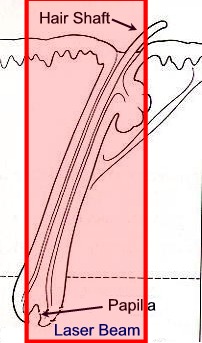
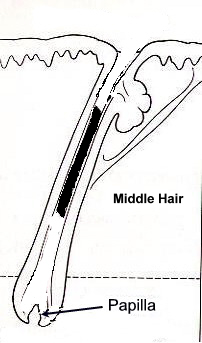
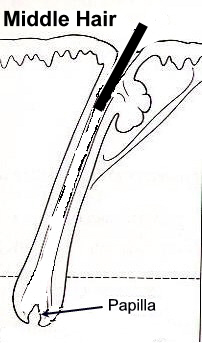
Diagram
©2001 Marcelle C. Kutun Electrolysis
& Laser Specialists, Inc.
Back to Top
of FAQs
If
I try to tweeze a hair with a little tug, and it DOES offer resistance, does
that mean that the treatment didn't work on that hair?
If the hair offers resistance
it means that it is probably still attached to the papilla. DO NOT TWEEZE IT!
Back to Top
of FAQs
Is
there any reason NOT to tweeze? That is, should I just wait for the shedding
for some reason? Does tweezing change the hair follicle at all?
For shedding hair use a loofa
brush or baby oil to exfoliate the area. The ban against tweezing is that,
before treatment, you remove the hair from the papilla and, thus, it can't be
treated. The aim of LHR, and electrolysis, is to disable the papilla. Tweezing
and/or waxing before LHR is a NO-NO! Tweezing the shedding hair is OK, but only
the shedding ones. The loofa works better and faster.
Back to Top
of FAQs
Top of page
|
FAQS ABOUT VASCULAR
AND PIGMENTED LESIONS
|
The light of the laser is selectively absorbed by blood and
pigment. It passes harmlessly through the skin and gently heats
the vessel to destroy it.
Back to
FAQS ABOUT LESIONS
All areas of the body can be treated. Most commonly performed
treatments are on the face and legs.
Back to
FAQS ABOUT LESIONS
It depends on the area being treated. It will typically take 20
minutes to treat a full face.
Back to
FAQS ABOUT LESIONS
Anesthesia is not required - the only effect felt is a hot and
tingling sensation that is well tolerated.
Back to
FAQS ABOUT LESIONS
Complications are rare. Skin lightening or darkening may occur,
especially if tanned skin is exposed to laser. It is advisable
to wear sunblock when in the sun during the month following
laser treatment.
Back to
FAQS ABOUT LESIONS
Many results are obtained after a single session for darker
pigmented lesions, but an additional sessions may be
required. Lighter pigmented lesions may require multiple
treatments.
Vascular lesions will show an improvement 8 - 12 weeks following
your initial treatment.
Multiple treatments are typical and should be
expected at 8 - 12 week intervals.
Back to
FAQS ABOUT LESIONS
A fading of the vessels and pigmented lesions after your initial
treatment. Results are gradual. Pigmented lesions will fade in
about 2 weeks while Vascular lesions can take up to 12 weeks.
Back to
FAQS ABOUT LESIONS
Yes. Treated vessels should not re-appear. Laser treatments,
however, do not prevent the formation of new lesions or vessels.
Back to
FAQS ABOUT LESIONS
Side effects are minimal and are generally limited to a slight
redness of the skin which should not persist for more than a few
hours.
Back to
FAQS ABOUT LESIONS
Yes, you can re-apply make-up immediately after the procedure.
Back to
FAQS ABOUT LESIONS |
Back to
Top of FAQs
Top of page |
|
